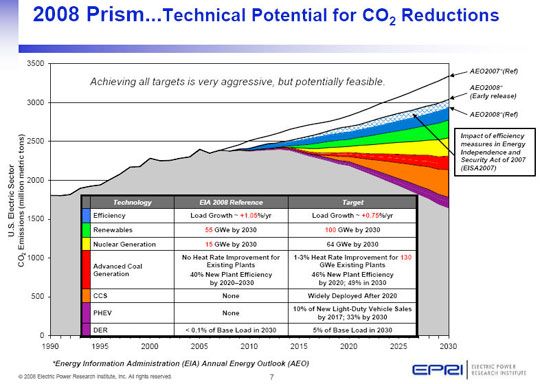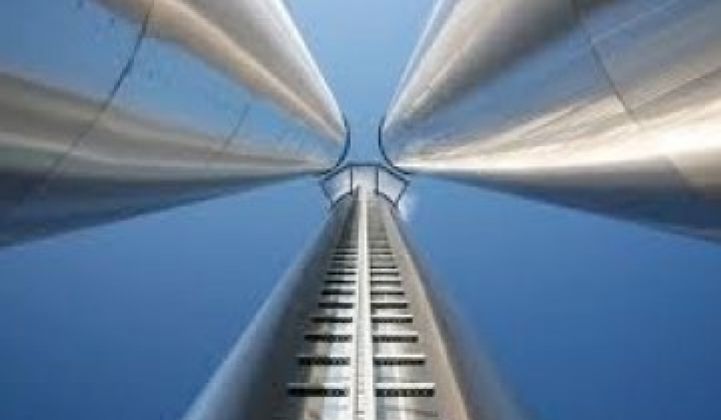Professor Sally Benson, the Director of Stanford University's Global Climate and Energy Project, has been active in the Carbon Capture and Sequestration (CCS) community for about twelve years and has accumulated enormous technical insight into this field. She is a ground water hydrologist and reservoir engineer by training, and her research group focuses on CCS.
Benson gave a lecture at the Stanford event on Tuesday and provided an overview of CCS technologies and issues: CCS 101.
Here's a summary of her lecture:
The Case for CCS
We would not need CCS at all without the threat of global warming. So if you are a global warming skeptic -- you may not want to read on.
According to Benson, we are not running out of fossil fuels and decreasing our reliance on fossil fuels will be challenging. There's at least a 100-year supply of oil, gas, gas hydrates and coal.
In Benson's viewpoint, CCS is expected to contribute about 20 percent to the needed CO2 emission reduction. This jibes with EPRI's Prism Chart, which has CCS and a yet-to-be-scaled technology providing this enormous impact.

CCS Technologies
CCS is a four-step process used to deal with coal or natural gas plant effluent, of which 5 percent to 15 percent is CO2. The four steps are:
- Capture
- Compression
- Pipeline transport
- Geologic sequestration
There are currently three methods for CCS (next three images from co2crc):
Post-combustion capture: CO2 is captured after fuel has been burned. It's a mature technology and a reasonably standard retrofit. But there's a high energy penalty (~30%) and high cost for capture -- anywhere from $30 per ton of CO2 to several hundreds of dollars per ton -- which translates to a cost increase ranging from 50 percent to 100 percent. Benson estimated the cost as an "8 cents to 10 cents per kw-hr" adder "for the Nth plant."
Oxy-Combustion: CO2 captured during fuel combustion avoids complex post-combustion separation.
Pre-combustion capture: CO2 is captured before fuel is burned; IGCC has lower costs than post-combustion, lower energy penalties (10 percent to 15 percent) and the bonus (?) of H2 production. But it's a complex chemical process, and not possible to retrofit without a large capital investment.
Membrane technology is being investigated, but is a long way from being used in this wet and dirty environment.
Compression and Transport
Compression of CO2 to a liquid state (about 100 bars) -- compression is a mature technology
Transport of liquid CO2 in pipelines -- pipeline transport is a mature technology with over 2,000 miles of pipelines in the U.S.
Geological Sequestration -- Where are We Going to Put it?
The super critical carbon dioxide is injected into sedimentary basins -- geological formations with alternating layers of sandstone and shale. There are enormous resources of sedimentary basin resources on- and off-shore. Benson said if we decided to sequester CO2 in a big way we could do it for 100 years without running out of capacity.
Geological Storage Options:
- Depleted oil and gas reservoirs -- lowest risk
- Use of CO2 in enhanced oil and gas recovery -- simultaneous oil extraction with CCS
- Deep saline formations -- both offshore and onshore
- Use of CO2 in enhanced coal bed methane recovery --the CO2 become part of the rock
Current CCS Sites
The Sleipner Project, located off-shore in the North Sea off Norway from 1996 to present, involves one Mt CO2 injection per year with Seismic monitoring. This is the most important saline aquifer, according to Benson, and the "gold standard for monitoring."
In Salah Algeria project (active since 2004, natural gas sequestration)
![]()
Other projects include Snovhit, Norway (active since 2008) and Weyburn, Canada (active since 2000).
American utility AEP has drilled a number of two-mile holes in the ground and is experimenting with CCS. However, it's not the technology of CCS that keeps the CEO of AEP awake up at night, but rather, the government oversight. In Michael Morris' view, the technology is there and it's just a matter of making it scalable. AEP has looked at two technologies -- an amine process and a chilled ammonia process -- and has chosen to go with the ammonia process with their partners from Alstom.
Morris claims that CCS results in a small efficiency penalty, but also contends that 90% of the carbon can be captured from the facility. AEP wants to prove that is scalable by 2014 or 2015.
Is there a liability associated with a CO2 storage system? Yes, according to Morris, but it's the same liability that comes with stored propane stored or radioactive waste. If the liability comes from mishandling, it becomes a shareholder issue. But it's insurable, and rare crises, such as a fissure or a massive escape, can be insured against, as well.
What Could Go Wrong?
Potential Release Pathways
- Well leakage in injection and abandoned wells; wells have to be carefully constructed
- Poor site characterization
- Excessive pressure buildup damages seal
Potential consequences
- Worker safety
- Groundwater quality degradation
- Resource damage
- Ecosystem degradation
- Public safety
- Structural damage
- Release to atmosphere
Benson's Conclusions
- CCS is an important part of solving the global warming problem
- The technology is sufficiently mature for commercial projects
- Research is needed to support deployment at scale
- Institutional issues and incentives need to be aggressed to support widespread deployment
***
Comments
Despite her deep technical knowledge, Professor Benson might not be the most unbiased judge of the practical viability of CCS technology in the non-research world. It is in her own self-interest for CCS research to be conducted and for funding to be directed towards this technology.
At the start of the lecture, the audience was polled for some preliminary questions, and the only person to ask about cost was this reporter. No questions regarding policy were posed, either. I realize that this is an engineering-centric audience, but I was surprised by those omissions.
When it comes to incumbent energy players, especially coal and natural gas plants -- the only motivations are policy, legal frameworks, and cost. To ignore these factors or gloss over them sets CCS up to forever be the technology of the future. No coal plant owner would institute this type of technology without a mandate or carbon tax in place.



